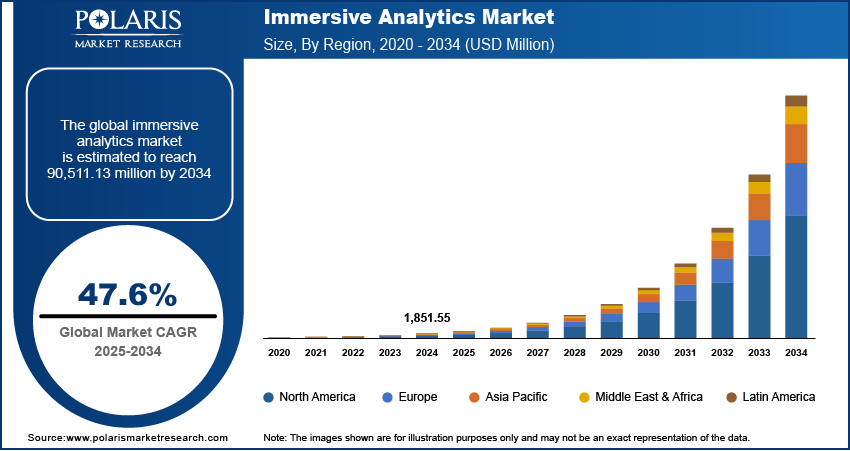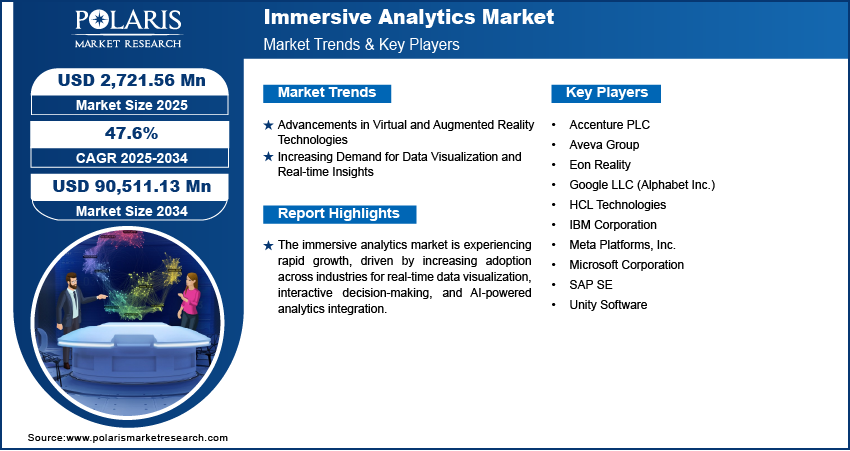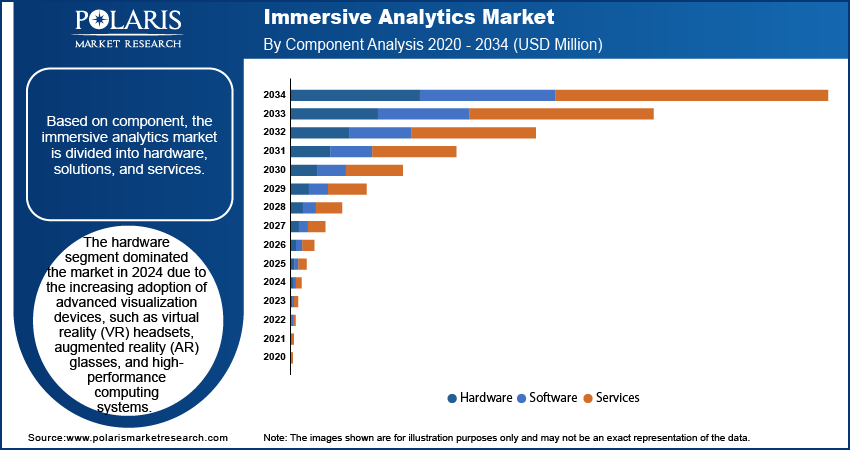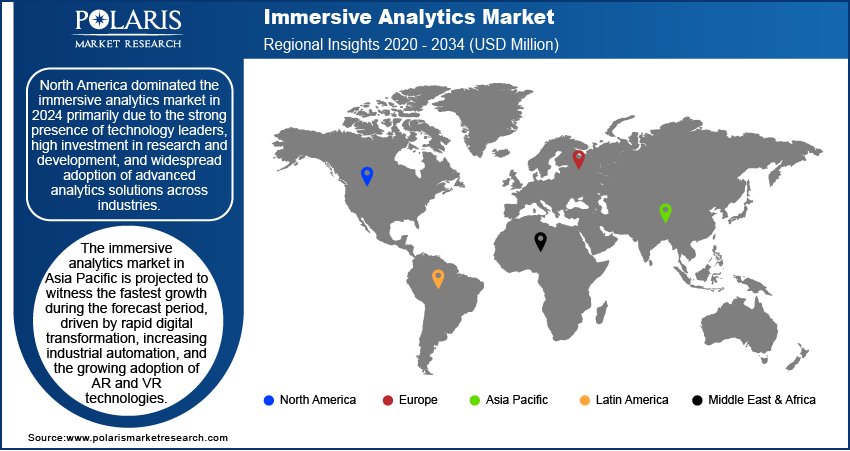
Immersive Analytics Market Size, Share, Trends, Industry Analysis Report: By Component (Hardware, Solutions, and Services), Application, End Use, and Region (North America, Europe, Asia Pacific, Latin America, and Middle East & Africa) – Market Forecast, 2025–2034
- Published Date:Apr-2025
- Pages: 129
- Format: PDF
- Report ID: PM5504
- Base Year: 2024
- Historical Data: 2020-2023
Immersive Analytics Market Overview
The global immersive analytics market was valued at USD 1,851.55 million in 2024. It is expected to grow from USD 2,721.56 million in 2025 to USD 90,511.13 million by 2034, at a CAGR of 47.6% from 2025 to 2034.
Immersive analytics refers to the use of advanced visualization and interactive technologies, such as virtual reality (VR), augmented reality (AR), and mixed reality (MR), to improve data analysis and decision-making.
The growing need for data-driven decision-making is driving the immersive analytics market growth, as organizations increasingly rely on real-time insights to optimize operations and improve strategic outcomes. Traditional data analysis methods often present challenges in interpreting complex datasets, whereas immersive analytics enables a more intuitive and interactive approach. Businesses can identify patterns, trends, and anomalies more efficiently by leveraging spatial computing and 3D visualization. This capability is particularly beneficial in sectors such as healthcare, finance, and manufacturing, where data precision and real-time decision-making are crucial. For instance, in March 2025, Boomi launched AI Studio, a secure AI management solution enabling organizations to design, govern, and orchestrate AI agents at scale. This innovation highlights the growing integration of AI and immersive technologies to address challenges in security, compliance, and interoperability, ensuring seamless integration and governance across enterprise ecosystems. The demand for immersive analytics solutions is expected to rise as the volume and complexity of data continue to expand, enabling organizations to achieve improved operational efficiency and gain competitive advantage.

To Understand More About this Research: Request a Free Sample Report
Another key market driver is the integration with the Internet of Things (IoT) for enhanced data analysis. IoT devices generate vast amounts of real-time data, which, when combined with immersive visualization, can provide deeper insights into system performance, predictive maintenance, and operational efficiency. For instance, in February 2025, Skylytics Data collaborated with Zoho Corporation to offer Zoho’s IoT platform in the US. This collaboration enables businesses to leverage real-time data insights to optimize operations and drive digital transformation through advanced IoT and data analytics. Integrating these technologies enhances situational awareness and decision-making. As IoT adoption continues to rise across industries, the synergy between immersive analytics and IoT-driven data insights is poised to drive immersive analytics market demand, enabling more effective and data-driven business strategies.
Immersive Analytics Market Driver Dynamics
Advancements in Virtual and Augmented Reality Technologies
Traditional data analysis tools often present limitations in visualizing multidimensional datasets, whereas virtual reality (VR) and augmented reality (AR) enable a more interactive and intuitive experience. For instance, in January 2025, OPTIX launched its AR waveguide module, EPIC 50, with a 50-degree FoV and a foveated rendering feature for its 8K VR Pancake Module. These innovations aim to improve AR/VR display quality and performance for next-gen devices. AR and VR technologies facilitate real-time spatial representation, allowing users to explore large datasets in three-dimensional environments for improved pattern recognition and decision-making. Enhanced hardware capabilities, such as high-resolution displays, motion tracking, and haptic feedback, further contribute to a seamless analytical experience. Thus, as VR and AR technologies continue to evolve, their integration with immersive analytics solutions is expected to drive immersive analytics adoption across industries, enabling more efficient and informed data-driven strategies.
Increasing Demand for Data Visualization and Real-Time Insights
The increasing demand for data visualization and real-time insights is another major driver of the immersive analytics market expansion, as organizations seek more effective ways to interpret and act on large volumes of data. Traditional dashboard-based analytics often struggle to present complex relationships and dynamic data streams intuitively. Immersive analytics addresses this challenge by offering interactive visual representations, enabling users to explore data in real time and derive actionable insights. This capability is particularly crucial in fast-paced environments where timely decision-making greatly impacts operational efficiency and business outcomes. For instance, in August 2024, a GAO report revealed that 17 of 23 US Federal civilian agencies used immersive technologies in FY 2022-2023 for workforce training, public outreach, and mission execution, with agencies like DHS training 10,000 employees in law enforcement and emergency response. This demonstrates how immersive analytics is being adopted across sectors to enhance situational awareness and decision-making. Businesses improve situational awareness, enhance predictive analytics, and gain deeper insights by leveraging immersive data visualization, ultimately leading to more informed strategic decision-making.

Immersive Analytics Market Segment Insights
Immersive Analytics Market Assessment by Component Outlook
The global immersive analytics market assessment, based on component, includes hardware, solutions, and services. The hardware segment dominated the immersive analytics market expansion in 2024 due to the increasing adoption of advanced visualization devices, such as virtual reality (VR) headsets, augmented reality (AR) glasses, and high-performance computing systems. These hardware components play a crucial role in delivering immersive data visualization experiences by providing high-resolution displays, real-time tracking, and interactive interfaces. The demand for specialized hardware has surged as industries increasingly integrate immersive analytics into their operations, driving growth opportunities. Additionally, continuous advancements in processing power, display technology, and sensor integration have improved the capabilities of immersive analytics solutions, further solidifying the dominance of the hardware segment.
Immersive Analytics Market Evaluation by End Use Outlook
The global immersive analytics market evaluation, based on end use, includes aerospace & defense, manufacturing, automotive, education, media & entertainment, gaming, healthcare, retail & e-commerce, and others. The healthcare segment is expected to witness the fastest growth during the forecast period, driven by the increasing need for advanced data visualization and real-time decision-making in medical diagnostics, treatment planning, and research. Immersive analytics enables healthcare professionals to interact with complex medical data, such as imaging scans and patient records, in three-dimensional environments for improved accuracy and efficiency. The integration of AR and VR technologies enhances surgical planning, medical training, and remote consultations, leading to better patient outcomes. Additionally, the rising adoption of AI-driven healthcare analytics and personalized medicine is accelerating the demand for immersive analytics solutions in the sector.

Immersive Analytics Market Regional Analysis
By region, the report provides the immersive analytics market insights into North America, Europe, Asia Pacific, Latin America, and the Middle East & Africa. North America dominated the immersive analytics market in 2024 primarily due to the strong presence of technology leaders, high investment in research and development, and widespread adoption of advanced analytics solutions across industries. For instance, in September 2024, the US Department of State announced a partnership for Global Inclusivity on AI (PGIAI) with tech giants like Google, Microsoft, and OpenAI, committing over USD 100 million to promote equitable AI access, capacity building, and sustainable development globally. The region benefits from the early adoption of emerging technologies, such as VR and AR, which have been extensively integrated into data-driven decision-making processes. Additionally, industries such as healthcare, aerospace & defense, and manufacturing have increasingly deployed immersive analytics to improve operational efficiency and innovation. The region’s robust digital infrastructure, coupled with supportive government initiatives and funding for technology advancements, has strengthened North America’s leadership in the immersive analytics market.
The Asia Pacific immersive analytics market is projected to witness the fastest growth during the forecast period, driven by rapid digital transformation, increasing industrial automation, and the growing adoption of AR and VR technologies. Countries in the region are experiencing a surge in demand for advanced data analytics solutions across sectors such as manufacturing, healthcare, retail, and education. Additionally, government initiatives promoting smart city development and Industry 4.0 adoption are accelerating the integration of immersive analytics into business operations. For instance, according to a December 2024 report by the IBEF, Nissan AMIEO partnered with Anaplan to digitalize its car flow process using AI and machine learning, enhancing production forecasting, dealer stock management, and customer sales. This initiative highlights how immersive analytics and AI-driven solutions are being leveraged to improve agility, responsiveness, and decision-making in the region. The expanding technology ecosystem, along with increasing investments in digital infrastructure and AI, is expected to further boost market growth in Asia Pacific.

Immersive Analytics Market – Key Players and Competitive Insights
The competitive landscape features global leaders and regional players competing for immersive analytics market share through innovation, strategic alliances, and regional expansion. Global players utilize strong R&D capabilities, technological advancements, and extensive distribution networks to deliver advanced solutions, meeting the growing demand for disruptive technologies and sustainable value chains. Immersive analytics market trends highlight rising demand for emerging technologies, digitalization, and business transformation driven by economic growth, geopolitical shifts, and macroeconomic trends. Global players focus on strategic investments, mergers and acquisitions, and joint ventures to strengthen their market position. Post-merger integration and strategic alliances are key strategies to improve competitive positioning and expand regional footprints. Regional companies, meanwhile, address localized needs by offering cost-effective solutions and leveraging economic landscapes. Competitive benchmarking includes market entry assessments, expansion opportunities, and partnership ecosystems to meet the demand for innovative products and future-ready solutions.
The market is experiencing technological advancements, such as disruptive technologies and digital transformation, reshaping industry ecosystems. Companies are investing in supply chain management, procurement strategies, and sustainability transformations to align with immersive analytics market demand, trends, and future development strategies. Pricing insights, revenue growth analysis, and competitive intelligence are critical for identifying opportunities and driving long-term profitability. In conclusion, the immersive analytics market growth is driven by technological innovation, market adaptability, and regional investments. Major players focus on strategic developments, market penetration, and competitive benchmarking to address economic and geopolitical shifts, assuring sustained growth in a hypercompetitive global market. A few key major players are Accenture PLC; Aveva Group; Eon Reality; Google LLC (Alphabet Inc.); HCL Technologies; IBM Corporation; Meta Platforms, Inc.; Microsoft Corporation; SAP SE; and Unity Software.
HCL Technologies is a global IT services company renowned for its innovative solutions and technological advancements. Founded in 1976, HCL has evolved greatly, transforming from a startup to a leader in AI, cloud, and digital technologies. The company offers a wide range of services, such as IT and business services, engineering and R&D services, and products and platforms. HCL Technologies is particularly noted for its immersive analytics solutions, which leverage AI and machine learning to provide actionable insights. For instance, HCL's AI-infused analytics Solution (ADvantage Analytics) integrates with Azure data services to improve decision-making by simplifying data consumption and providing real-time insights. In the domain of immersive analytics, HCL extends its capabilities through its Metaverse solutions. The HCLTech Metaverse solution enables businesses to create immersive customer experiences across industries, including retail. This platform allows customers to interact with virtual environments, such as trying on clothing virtually, and provides valuable feedback through extended analytics on user preferences and choices. HCL's analytics practice combines statistics, computer science, and visual analytics to deliver decision intelligence, further improving its immersive analytics offerings.
Meta Platforms, Inc., formerly known as Facebook, Inc., is a multinational technology company headquartered in Menlo Park, California. The company owns and operates several major platforms, such as Facebook, Instagram, WhatsApp, and Oculus, with a focus on connecting people and building communities. In 2021, Meta rebranded to emphasize its mission to build the metaverse, an integrated environment that combines virtual and physical realities to create immersive experiences. This vision aligns with the emerging field of immersive analytics, which leverages technologies such as VR, AR, and mixed reality (MR) to transform data visualization. Immersive analytics offers a more interactive and engaging approach to data interpretation by providing a three-dimensional space to explore complex datasets. Meta, through its Oculus series, has made substantial progress in VR technology, enabling users to immerse themselves in fully digital environments and gain deeper insights into data. The company's investment in VR and AR highlights its commitment to advancing immersive analytics, which has potential applications across various sectors, including business intelligence, healthcare, and education.
List of Key Companies in Immersive Analytics Market
- Accenture PLC
- Aveva Group
- Eon Reality
- Google LLC (Alphabet Inc.)
- HCL Technologies
- IBM Corporation
- Meta Platforms, Inc.
- Microsoft Corporation
- SAP SE
- Unity Software
Immersive Analytics Industry Developments
March 2025: ScaleOut Software launched Version 4 of its Digital Twins platform. The platform integrates OpenAI’s generative AI and ML enhancements for real-time anomaly detection, improved monitoring, and automatic algorithm retraining to optimize complex system management.
March 2025: Pure Storage launched FlashBlade//EXA, a high-performance data storage platform designed for AI and HPC workloads. It addresses metadata bottlenecks and delivers over 10TB/s read performance, setting a new industry standard for large-scale data storage.
March 2025: Supermicro launched compact edge servers optimized for AI inferencing and embedded workloads, powered by Intel Xeon 6 SoC processors. These systems enhance real-time data processing and decision-making at the edge, targeting industries such as telecom, networking, and CDN.
Immersive Analytics Market Segmentation
By Component Outlook (Revenue, USD Million, 2020–2034)
- Hardware
- Solutions
- Services
By Application Outlook (Revenue, USD Million, 2020–2034)
- Education and Training
- Sales and Marketing
- Design and Visualization
- Others
By End Use Outlook (Revenue, USD Million, 2020–2034)
- Aerospace & Defense
- Manufacturing
- Automotive
- Education
- Media & Entertainment
- Gaming
- Healthcare
- Retail & E-commerce
- Others
By Regional Outlook (Revenue, USD Million, 2020–2034)
- North America
- US
- Canada
- Europe
- Germany
- France
- UK
- Italy
- Spain
- Netherlands
- Russia
- Rest of Europe
- Asia Pacific
- China
- Japan
- India
- Malaysia
- South Korea
- Indonesia
- Australia
- Vietnam
- Rest of Asia Pacific
- Middle East & Africa
- Saudi Arabia
- UAE
- Israel
- South Africa
- Rest of Middle East & Africa
- Latin America
- Mexico
- Brazil
- Argentina
- Rest of Latin America
Immersive Analytics Market Report Scope
|
Report Attributes |
Details |
|
Market Size Value in 2024 |
USD 1,851.55 million |
|
Market Size Value in 2025 |
USD 2,721.56 million |
|
Revenue Forecast by 2034 |
USD 90,511.13 million |
|
CAGR |
47.6% from 2025 to 2034 |
|
Base Year |
2024 |
|
Historical Data |
2020–2023 |
|
Forecast Period |
2025–2034 |
|
Quantitative Units |
Revenue in USD million and CAGR from 2025 to 2034 |
|
Report Coverage |
Revenue Forecast, Market Competitive Landscape, Growth Factors, and Industry Trends |
|
Segments Covered |
|
|
Regional Scope |
|
|
Competitive Landscape |
|
|
Report Format |
|
|
Customization |
Report customization as per your requirements with respect to countries, regions, and segmentation. |
FAQ's
The global immersive analytics market size was valued at USD 1,851.55 million in 2024 and is projected to grow to USD 90,511.13 million by 2034.
The global market is projected to register a CAGR of 47.6% during the forecast period.
North America dominated the immersive analytics market revenue in 2024.
Some of the key players in the market are Accenture PLC; Aveva Group; Eon Reality; Google LLC (Alphabet Inc.); HCL Technologies; IBM Corporation; Meta Platforms, Inc.; Microsoft Corporation; SAP SE; and Unity Software
The hardware segment dominated the immersive analytics market in 2024.
The healthcare segment is expected to witness the fastest immersive analytics market growth during the forecast period.
